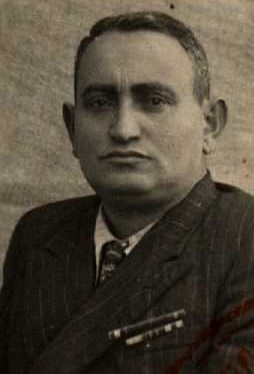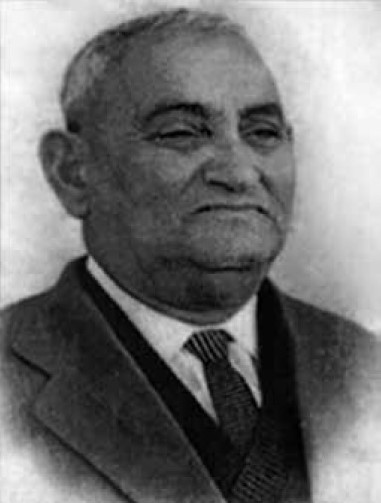An Azerbaijani, who was born in Shusha and served as chief surgeon of the Tajik SSR: Khanlar Hajiyev

Azerbaijani surgeon, Doctor of Medicine, Major General of the medical service, professor Khanlar Javad oglu Hajiyev was born on November 27, 1903 in a working-class family in Shusha.
[“Bakinskiy rabochiy” newspaper № 2 (15425) 3.01.1969, p. 4]
[Azerbaijani soviet encyclopedia. Volume Х. 1987, p. 154]
[Order of the Patriotic War, 2nd class. Award document. 1944, p. 2]
After Khanlar Hajiyev graduated from the faculty of Medicine of the current National University of Uzbekistan named after Mirzo Ulugbek, Tashkent (1928), he was appointed to the surgical department of the Republican Hospital of the Tajik SSR (now the Republic of Tajikistan) as a registrar.
[“Bakinskiy rabochiy” newspaper № 2 (15425) 3.01.1969, p. 4]
[Azerbaijani soviet encyclopedia. Volume Х. 1987, p. 154]
Khanlar Hajiyev defended his Candidate’s dissertation in 1936 and his PhD dissertation in 1948.
[“Bakinskiy rabochiy” newspaper № 2 (15425) 3.01.1969, p. 4]
[Azerbaijani soviet encyclopedia. Volume Х. 1987, p.154]
In 1940, Khanlar Hajiyev was drafted into the Soviet army. After the Nazi Germany’s attack on the USSR (1941), Khanlar Hajiyev was wounded and shell-shocked in Kerch (Crimea) in May 1942. In 1943 he was appointed as an army surgeon. Khanlar Hajiyev was awarded with 1st and 2nd classes Orders of the Patriotic War as well as medals such as the Red Flag, the Red Star, “Badge of Honor”, “For the Defense of the Caucasus” for his success in military field surgery (provision of surgical care to the wounded), his services such as training of surgical personnel in the army and etc.
In the premium list of 1944, his services were described as follows:
“Thanks to the great work done by comrade Hajiyev on the medical and surgical support of the army troops, there was a significant percentage reduction of deaths from wounds; the treatment and recovery of the wounded were speeded. An increase in the percentage of returning to the army was also experienced…
…Prof. Hajiyev has done great work in order to save the lives of thousands of wounded fighters and officers”.
[Order of the Patriotic War, 1st class. Award document. 1944, p. 2]
[Red Star order. Award document. 1944, p. 2]
[Order of the Red Banner. Award document. 1945, p. 1]
[“Bakinskiy rabochiy” newspaper № 2 (15425) 3.01.1969, p. 4]
[“Vestnik Avitseni” journal, Volume 22, № 2 2020, p. 182]
[Azerbaijani soviet encyclopedia. Volume Х. 1987, p. 154]
In the 1940-1950s Khanlar Hajiyev was the chief surgeon of the Tajik SSR.
Soviet surgeon Yuri Viktorovich Shapiro wrote the following in his memoirs:
“Professor Khanlar Javadovich Hajiyev headed the Department of Faculty Surgery. He was chief surgeon of the republic. He was showing us operations on the thyroid gland – goitre is endemic to Tajikistan (it means that this disease is specific to this geographical area). These operations required expert surgical technique. A kilogram-weight goitre located behind the chest was not uncommon. Khanlar Javadovich, who had an Azerbaijani temperament, sometimes allowed us to attend him in operating rooms. The windows in the operating room vibrated from his cries, the tools flew to the wall, the assistants sweated. After the completion of the surgical operation his surgical nurse usually brought him her resignation letter, he recovered from the stress and apologized, calmed her down, poured her a cup of coffee – and the problem were solved peacefully.”
[“Zdraviy Smisl” journal, Vesna № 2 (35) 2005, p.5]
In 1945-1964 Hajiyev was chief of the Department of Hospital Surgery of the North Ossetian State Medical Academy in Vladikavkaz (Russia). However, according to the scientific-medical journal – “Vestnik Kavkaza”, in 1946-1971 Hajiyev headed the aforementioned Department in the Avicenna (Abuali Ibni Sino) Tajik State Medical University in Dushanbe.
[“Bakinskiy rabochiy” newspaper № 2 (15425) 3.01.1969, p. 4]
[Azerbaijani soviet encyclopedia. Volume Х. 1987, p. 154]
[“Vestnik Avitseni” journal, Volume 22, № 2 2020, p. 182]
Y. Shapiro mentioned that Khanlar Hajiyev, chief surgeon of the Tajik SSR, came into conflict with Rumyantsev who was a doctor from Rostov. He wrote the following:
“In 1853 Khanlar Javadovich experienced an unpleasant incident. In that period of the spreading of obscurantism in science, the odious figures of crooks appeared – one of them was a doctor Rumyantsev who “opened” a new chapter – tissue planting in Soviet medicine. In fact, there was nothing new in this, transplantation was done by Filatov in Odessa, by Kazakov in Moscow, reiz-therapy was applied in Germany at the beginning of the last century. The innovation was that «a newly appeared prophet» suggested transplantation of tissues of animals and long-lived birds to patients, considering them to have more potential energy. V. Ghafurov, who was the first secretary of the Central Committee of the Communist Party of Tajikistan (Bobojon Ghafurov, who held this position in 1946-1956), was suffering from diabetes. Rumyantsev had him given a transplant in the Kremlin hospital. In gratitude, Ghafurov invited him to Tajikistan. The General Surgery Clinic was selected to demonstrate his practice. All scheduled surgical operations were canceled and, in the early morning, government vehicles with party and Soviet nobles as well as their relatives began to approach the clinic. Several eagles were hunted in the mountains and were brought to the clinic. It was as if Rumyantsev was performing a religious ceremony in the surgical operating room. Nobody knew the reason for transplanting the liver, kidney, spleen and testicles to the patients. In the evening, an open medical meeting of the Scientific Council of the Institute was convened with the participation of everyone who is related to medicine. Rumyantsev was sitting in the seat of the Presidium, he was slightly drunk and was looking with disdain on provincial people. His report was a mixture of ignorance and insolence. When he said that the Minister of Health of the USSR had given him permission to make the transplantation to 40 cancer patients who had suffered from intractable forms of cancer and that all tumors and metastases had disappeared, the participants of the meeting opened their mouths with surprise. Khanlar Javadovich could not withstand it. He announced from the lectern that, as the chief surgeon of the Republic, he would sue any surgeon who intends to repeat such an “operation”. Rumyantsev began to shout and said that he had already experienced it, namely, he had made a transplantation to the Rostov prosecutor’s wife, who had suffered from untreated breast cancer, and her tumor had disappeared. Hajiyev publicly named him ignorant. A big scandal broke out. The next morning, the party bureau of the institute gathered and Hajiyev was expelled from the party. The issue of his dismissal from the position of head of the department was raised. But, at that time, Stalin died and the issue of sanctions was not raised again. Rumyantsev disappeared and, a few years later, Hajiyev took a position at the Baku Medical Institute and worked there until his death.”
[“Zdraviy Smisl” journal, Vesna №.2 (35) 2005, p. 5]
After moving to Baku in 1964, Khanlar Hajiyev became a head of the department of operative surgery of the Azerbaijan Medical University. From 1967 until his death, he headed the department of surgery in the Azerbaijan State Advanced Training Institute for Doctors named after Aziz Aliyev.
[“Bakinskiy rabochiy” newspaper № .2 (15425) 3.01.1969, p. 4]

Khanlar Hajiyev was a member of the Board of Directors of the All-Union Society of Surgeons and a member of the Presidium of the Azerbaijan Society of Surgeons for many years. He successfully operated on patients with chest, abdominal, oncological and urological diseases. He also perfectly knew several European languages.
[“Bakinskiy rabochiy” newspaper № 2 (15425) 3.01.1969, p.4]
[“Vestnik Avitseni” journal, Volume 22, № 2 2020, p.182]
Khanlar Hajiyev died on January 2, 1969 in Baku.
[“Bakinskiy rabochiy” newspaper № 2 (15425) 3.01.1969, p.4]
[Azerbaijani soviet encyclopedia. Volume Х. 1987, p.154]